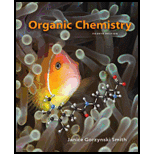
Concept explainers
(a)
Interpretation: Synthesis of the given compound from
Concept introduction: Terminal
Dehydrohalogenation reaction is class of reaction in which the removal of hydrogen halide takes place in presence of strong base.
In presence of sodium metal in ammonia, the is alkyne is reduced to
(b)
Interpretation: Synthesis of the given compound from
Concept introduction: Terminal alkynes can be converted into internal alkynes by forming new
Dehydrohalogenation reaction is class of reaction in which the removal of hydrogen halide takes place in presence of strong base.
(c)
Interpretation: Synthesis of the given compound from
and other required reagents is to be devised.
Concept introduction: Terminal alkynes can be converted into internal alkynes by forming new
Dehydrohalogenation reaction is class of reaction in which the removal of hydrogen halide takes place in presence of strong base.
Want to see the full answer?
Check out a sample textbook solution
Chapter 12 Solutions
Organic Chemistry
- Devise a synthesis of (E)-tetradec-11-enal, a sex pheromone of the spruce budworm, a pest that destroys fir and spruce forests, from acetylene, Br(CH2)10OH, and any needed organic compounds or inorganic reagents.arrow_forwardHow could you separate a mixture of the following compounds? The reagents available to you are water, ether, 1.0 M HCl, and 1.0 M NaOH.arrow_forwardDevise a synthesis of each compound from cyclopentanone, benzene, and organic alcohols having ≤ 3 C's. You may also use any required organic or inorganic reagentsarrow_forward
- Propose a synthesis of each compound starting from acetylene and any necessary organic and inorganic reagents. Q.) cis-4-Octenearrow_forwardHow should each of the following contents be prepared? Use the specified starting material and any other reagentsarrow_forwardwhich reagents complete the reaction?arrow_forward
 ChemistryChemistryISBN:9781305957404Author:Steven S. Zumdahl, Susan A. Zumdahl, Donald J. DeCostePublisher:Cengage Learning
ChemistryChemistryISBN:9781305957404Author:Steven S. Zumdahl, Susan A. Zumdahl, Donald J. DeCostePublisher:Cengage Learning ChemistryChemistryISBN:9781259911156Author:Raymond Chang Dr., Jason Overby ProfessorPublisher:McGraw-Hill Education
ChemistryChemistryISBN:9781259911156Author:Raymond Chang Dr., Jason Overby ProfessorPublisher:McGraw-Hill Education Principles of Instrumental AnalysisChemistryISBN:9781305577213Author:Douglas A. Skoog, F. James Holler, Stanley R. CrouchPublisher:Cengage Learning
Principles of Instrumental AnalysisChemistryISBN:9781305577213Author:Douglas A. Skoog, F. James Holler, Stanley R. CrouchPublisher:Cengage Learning Organic ChemistryChemistryISBN:9780078021558Author:Janice Gorzynski Smith Dr.Publisher:McGraw-Hill Education
Organic ChemistryChemistryISBN:9780078021558Author:Janice Gorzynski Smith Dr.Publisher:McGraw-Hill Education Chemistry: Principles and ReactionsChemistryISBN:9781305079373Author:William L. Masterton, Cecile N. HurleyPublisher:Cengage Learning
Chemistry: Principles and ReactionsChemistryISBN:9781305079373Author:William L. Masterton, Cecile N. HurleyPublisher:Cengage Learning Elementary Principles of Chemical Processes, Bind...ChemistryISBN:9781118431221Author:Richard M. Felder, Ronald W. Rousseau, Lisa G. BullardPublisher:WILEY
Elementary Principles of Chemical Processes, Bind...ChemistryISBN:9781118431221Author:Richard M. Felder, Ronald W. Rousseau, Lisa G. BullardPublisher:WILEY





